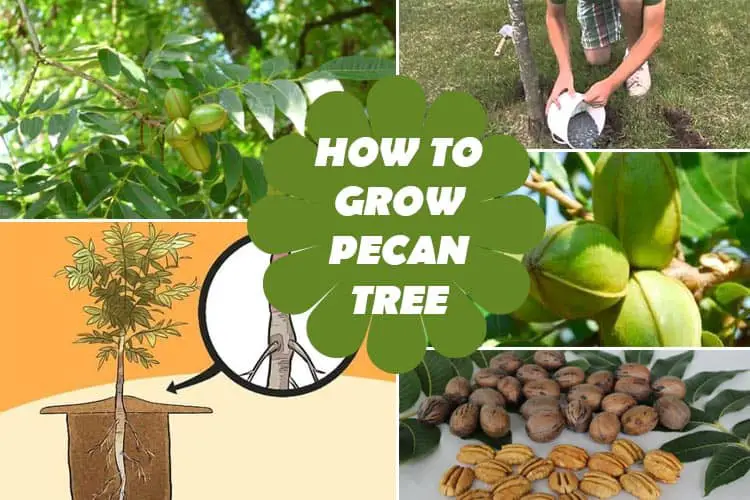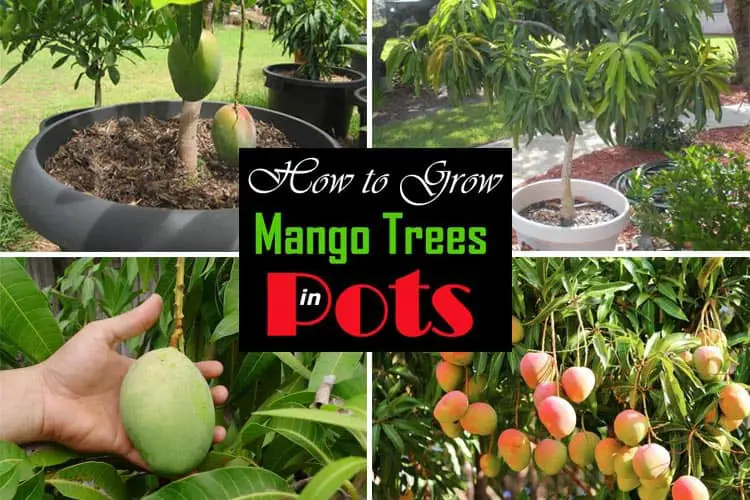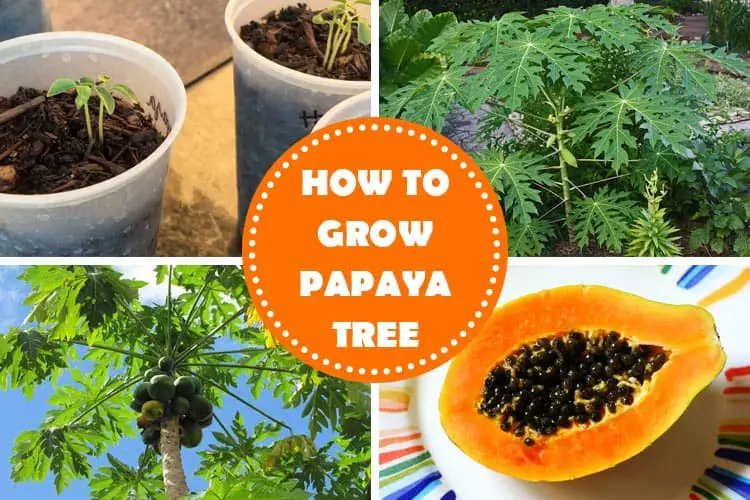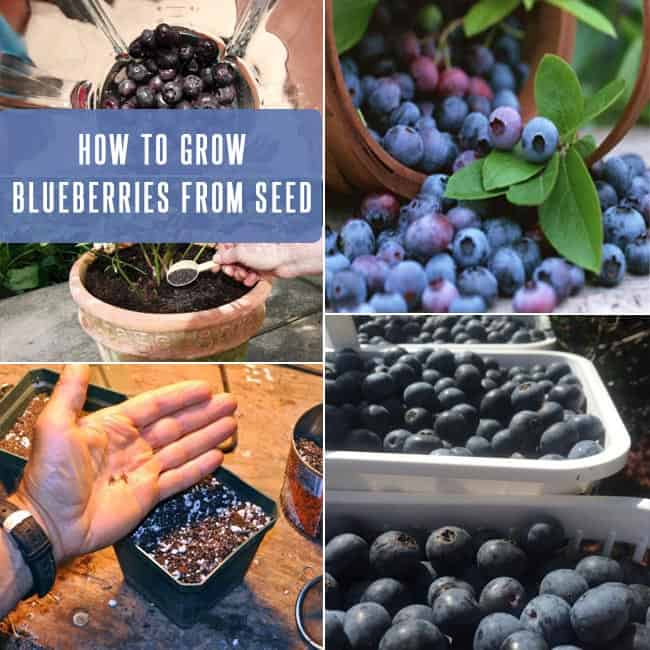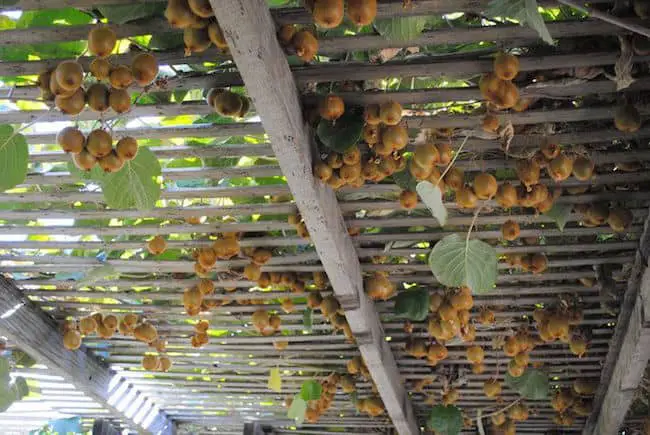14 Unusual Tropical Fruits You Can Grow at Home
Growing exotic tropical fruits in your own backyard transforms an ordinary garden into a lush paradise filled with rare flavors and stunning colors.
These remarkable plants offer more than just beautiful foliage—they produce creamy custards, jewel-toned berries, and caviar-like pearls that seem almost too extraordinary to be real.
From vines that cascade with purple blooms to trees bearing fruit directly on their trunks, each variety brings its own enchantment to your growing space, promising harvests that most people only find in far off markets.
Quick Summary
- Cherimoya, dragon fruit, finger lime, white sapote, and passion fruit offer unique flavors ranging from custard-like to intensely tart.
- Most tropical fruits require full sun, well-draining soil, and warm temperatures, with some adaptable to container growing.
- Pineapples can be grown from store-bought crowns in sunny spots, taking 18-24 months to produce golden fruit.
- Acerola cherry provides exceptional nutrition with up to 65 times more vitamin C than oranges and multiple yearly harvests.
- Jaboticaba and Monstera deliciosa require patience, with slow growth and fruits taking over a year to ripen fully.
Cherimoya (Custard Apple)
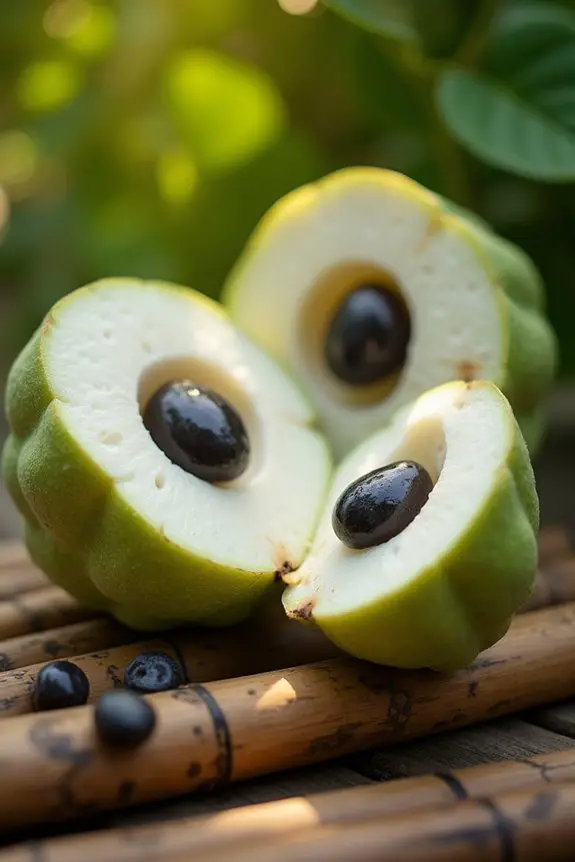
Often called the “ice cream fruit” for good reason, cherimoya delivers a creamy, custard-like texture that melts on the tongue like frozen dessert.
This heart-shaped treasure features pale green scaly skin that opens to reveal sweet white flesh tasting like tropical pineapple, banana, and papaya combined.
Cherimoya benefits include abundant vitamin C, fiber, and antioxidants that support overall wellness.
The fruit thrives in Mediterranean climates with mild winters and warm summers.
Gardeners can explore delicious cherimoya recipes ranging from smoothies to sorbets, transforming their homegrown harvest into desserts that rival any premium gelato shop creation.
Dragon Fruit (Pitaya)
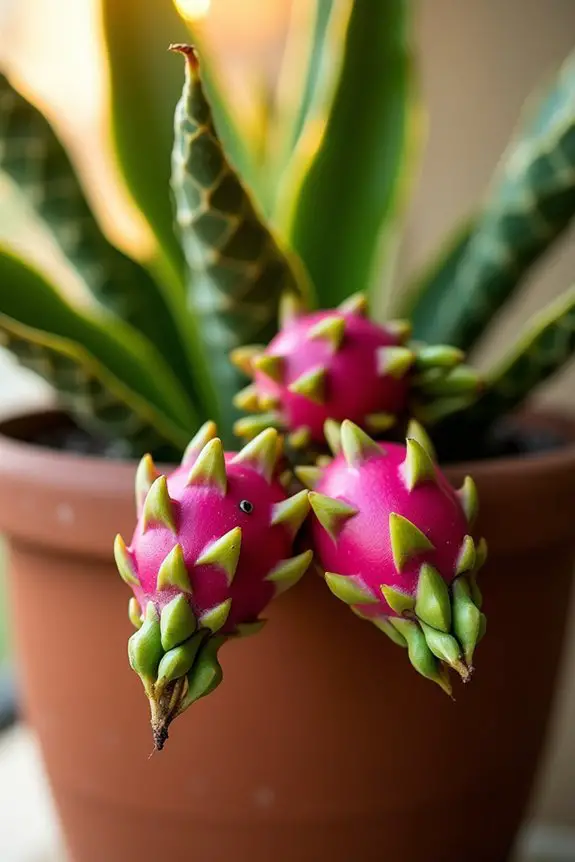
This vibrant cactus fruit captivates gardeners with its stunning magenta skin and dramatic leafy scales that inspired its mythical name.
Dragon fruit cultivation thrives in warm climates where these climbing cacti produce spectacular night-blooming flowers before yielding sweet, kiwi-textured flesh.
Dragon fruit varieties range from white-fleshed specimens with subtle sweetness to deep crimson types bursting with berry-like intensity.
These resilient plants adapt beautifully to containers, making tropical dreams accessible even in temperate regions.
With proper support structures and well-draining soil, gardeners watch their vines transform patios into exotic paradises, eventually harvesting jewel-toned fruits that taste like summer’s finest promise fulfilled.
Passion Fruit
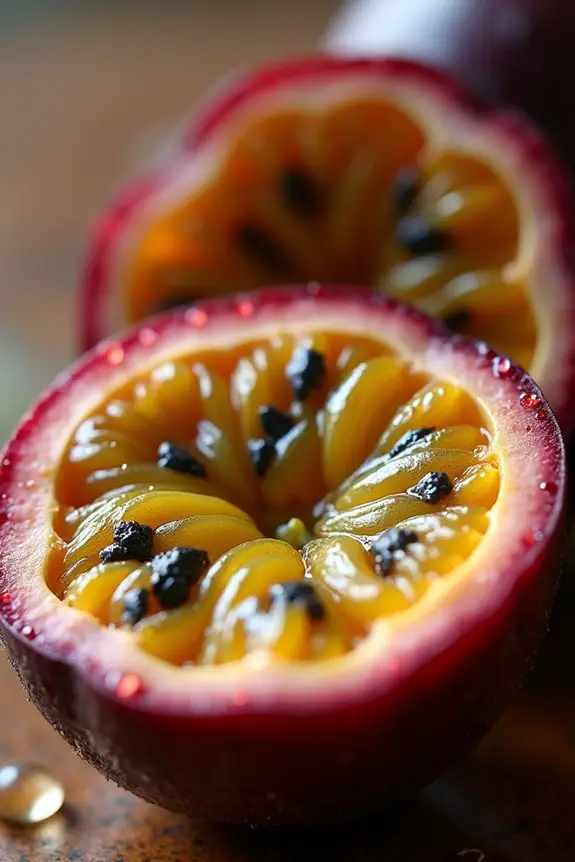
Vines cascading with purple blooms transform garden trellises into curtains of tropical enchantment where passion fruit dangles like nature’s hidden treasures.
These jewel-toned orbs burst with tangy sweetness that awakens every taste bud. Passion fruit varieties include the purple-skinned edulis and golden-yellow flavicarpa, both thriving in warm climates.
Growing conditions require full sunshine, well-draining soil, and sturdy support structures for climbing tendrils.
| Element | Requirement |
|---|---|
| Sunlight | 6-8 hours daily |
| Temperature | 65-85°F ideal |
| Water | Regular moisture |
| Support | Strong trellis |
Harvest begins within twelve months, rewarding patient gardeners with aromatic fruits perfect for refreshing beverages.
Guava
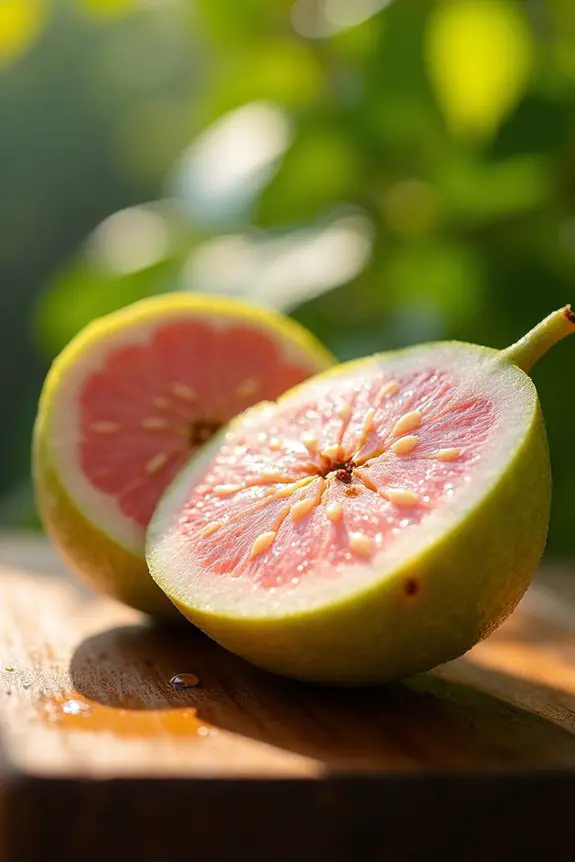
Fragrant blossoms herald the arrival of guava trees, transforming ordinary backyards into tropical paradises where pink-fleshed treasures ripen under sunny skies.
These resilient plants reward patient gardeners with sweet, aromatic fruits perfect for countless guava recipes, from silky smoothies to golden jams.
Multiple guava varieties thrive in containers or ground plantings, adapting beautifully to warm climates and protected spaces.
- White-fleshed varieties offer crisp texture and subtle sweetness for fresh eating
- Pink selections deliver intense tropical flavor ideal for preserves and beverages
- Dwarf cultivars fit perfectly in patio containers and small gardens
- Self-pollinating trees produce abundant harvests without requiring companion plants
- Year-round potential creates continuous fruiting cycles in frost-free regions
Loquat
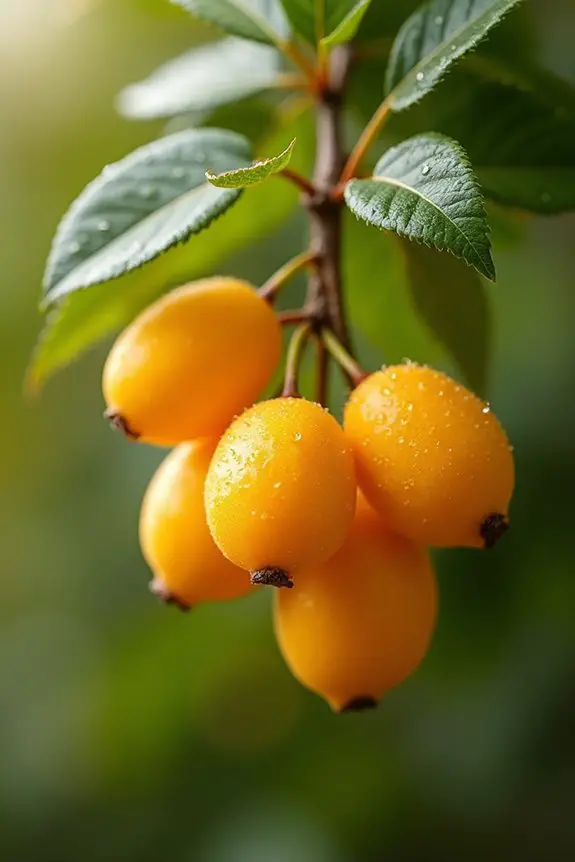
Golden orbs cluster among evergreen branches each spring, announcing loquat season with sunny promise and honeyed anticipation.
These amber-fleshed fruits taste like apricots kissed with mango sweetness, transforming gardens into personal orchards. Popular loquat varieties include ‘Gold Nugget’ and ‘Big Jim’, both producing generous harvests in mild climates.
The tree itself stays compact and manageable, perfect for smaller yards craving tropical flair. Fresh loquats shine in breakfast bowls, but creative loquat recipes transform them into tangy preserves, elegant tarts, and sunset-colored syrups.
Home growers realize that cultivating these glossy-leaved beauties brings both delicious rewards and year-round visual appeal.
Miracle Fruit
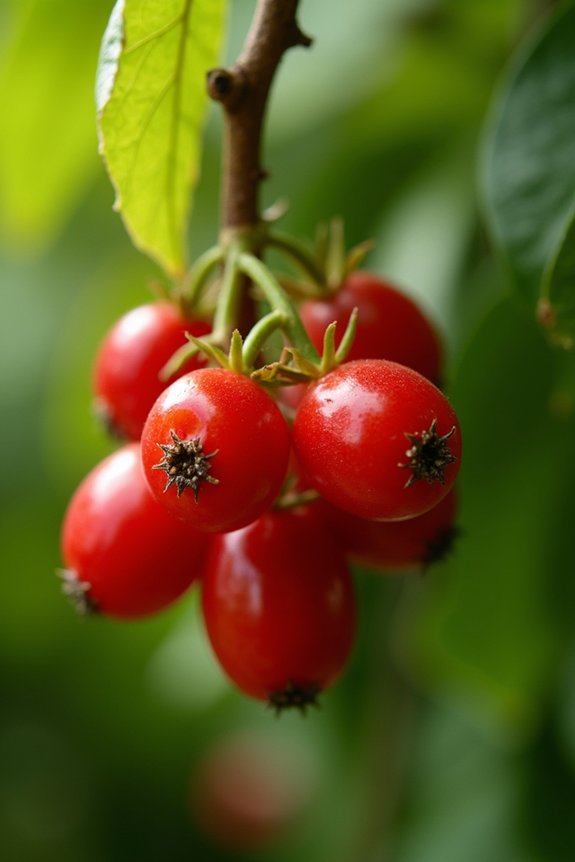
While loquats deliver dependable sweetness each spring, another botanical wonder operates through pure sensory enchantment rather than conventional flavor. Miracle fruit benefits include transforming sour tastes into sweet sensations through a protein called miraculin.
These ruby-red berries grow on compact evergreen shrubs, making miracle fruit cultivation achievable in containers or tropical gardens. The plant thrives in acidic soil with dappled shade, producing berries year-round in ideal conditions.
Growing tips for miracle fruit success:
- Maintain soil pH between 4.5-5.8 for optimal growth
- Provide bright indirect light and consistent moisture
- Use well-draining potting mix enriched with peat moss
- Fertilize monthly during growing season with acidic plant food
- Expect fruiting within 2-3 years from establishment
Starfruit (Carambola)
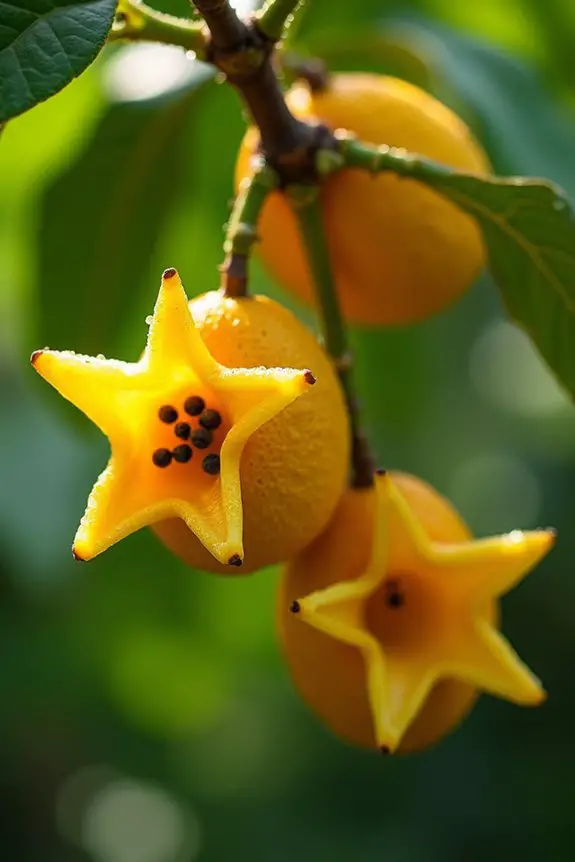
Few tropical fruits announce their presence quite like starfruit, with its distinctive ridged silhouette that transforms each slice into a perfect five-pointed star.
This golden-yellow treasure thrives in warm climates, rewarding patient gardeners with glossy waxy skin and crisp juicy flesh that tastes like tropical sunshine mixed with citrus notes.
| Growing Tips | Culinary Uses | Harvest Signs |
|---|---|---|
| Full sun required | Fresh salads | Bright yellow color |
| Well-drained soil | Tropical smoothies | Slight softness |
| Regular watering | Garnish platters | Brown ridge edges |
| Prune annually | Pickled preserves | Sweet fragrance |
| Frost protection | Juice beverages | Waxy sheen |
Jaboticaba (Brazilian Grape Tree)
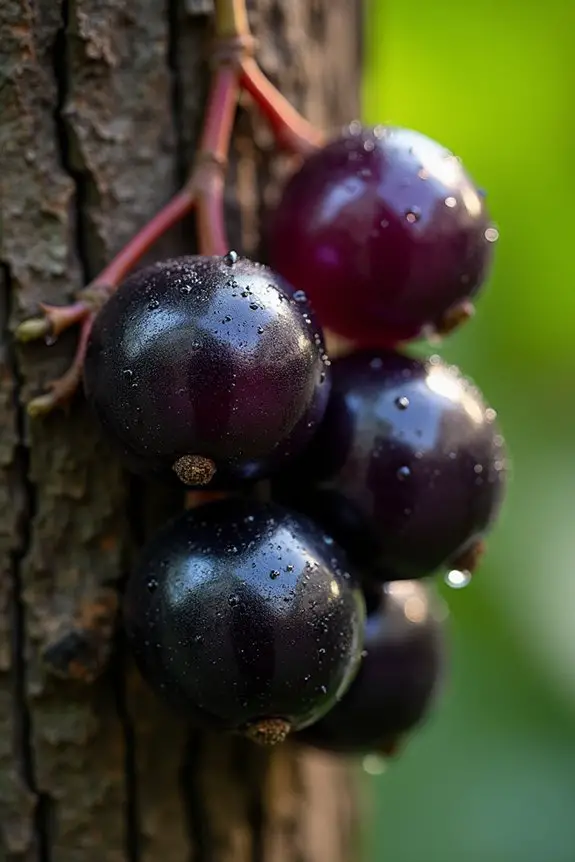
Among the most enchanting oddities of the fruit world, jaboticaba creates an unforgettable spectacle by producing glossy purple-black fruits directly on its trunk and branches.
This Brazilian treasure transforms into a living work of art during fruiting season, when hundreds of grape-like jewels emerge from weathered bark. The sweet-tart flavor rivals finest muscadines, making every harvest memorable.
Growing Jaboticaba Successfully:
- Provide acidic, well-draining soil with consistent moisture for optimal development
- Position in full sun to partial shade locations
- Expect slow initial growth but decades of reliable production
- Maintain temperatures above 25°F for survival
- Create ideal growing conditions mimicking subtropical Brazilian forests
Papaya
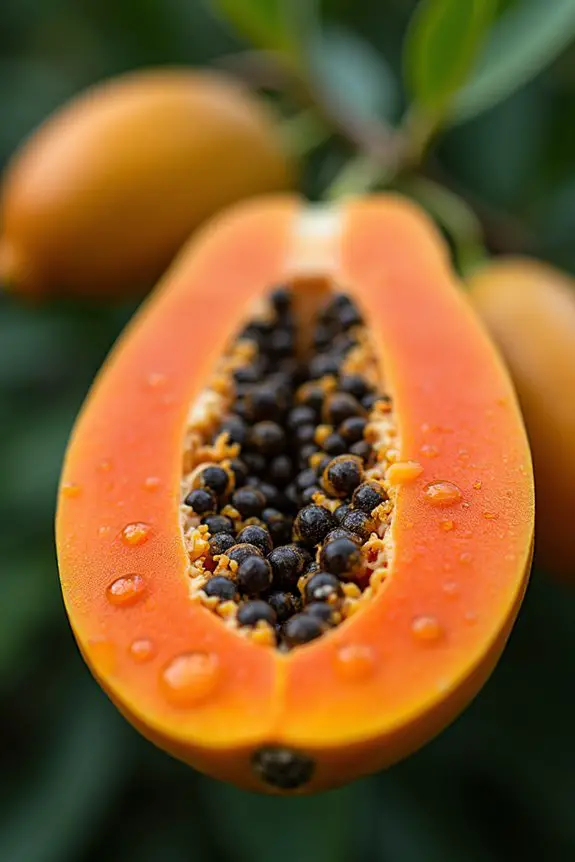
Sunshine captured in fruit form describes the magnificent papaya, a fast-growing tropical wonder that transforms backyard gardens into productive paradises within a single year.
These golden-orange treasures dangle like nature’s lanterns, offering extraordinary papaya health benefits including digestive enzymes and vitamin-rich sweetness.
Smart papaya cultivation tips ensure success: plant in well-draining soil, provide full sun exposure, and maintain consistent watering schedules.
For optimal germination success, plant multiple seeds to ensure you get both male and female plants since papayas require cross-pollination for fruit production.
| Growing Aspect | Recommendation |
|---|---|
| Sunlight Needs | 6-8 hours direct sun daily |
| Soil pH Level | 6.0-6.5 (slightly acidic) |
| Spacing Distance | 8-10 feet between trees |
| Harvest Timeline | 9-11 months from planting |
Pineapple
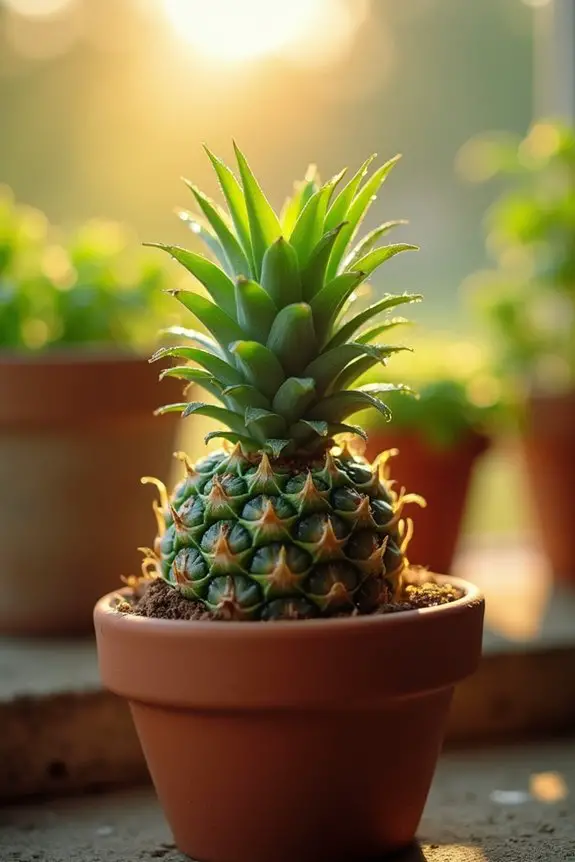
Crown jewels of the tropical fruit kingdom, pineapples reward patient gardeners with spectacular golden-yellow fruits that taste like pure summer bliss.
These magnificent specimens thrive in containers or garden beds, requiring minimal maintenance once established. Pineapple varieties range from compact ‘Sugarloaf’ to sweeter ‘Smooth Cayenne’, each offering unique flavors.
Pineapple planting begins with simply twisting off a store-bought crown and letting it dry for two days before nestling into well-draining soil.
- Select crowns with fresh, vibrant green leaves
- Position in bright, sunny spots with six hours of daily sunlight
- Water sparingly, allowing soil to dry between drinks
- Fertilize monthly during growing season
- Harvest after 18-24 months when fruit turns golden
Finger Lime (Caviar Lime)
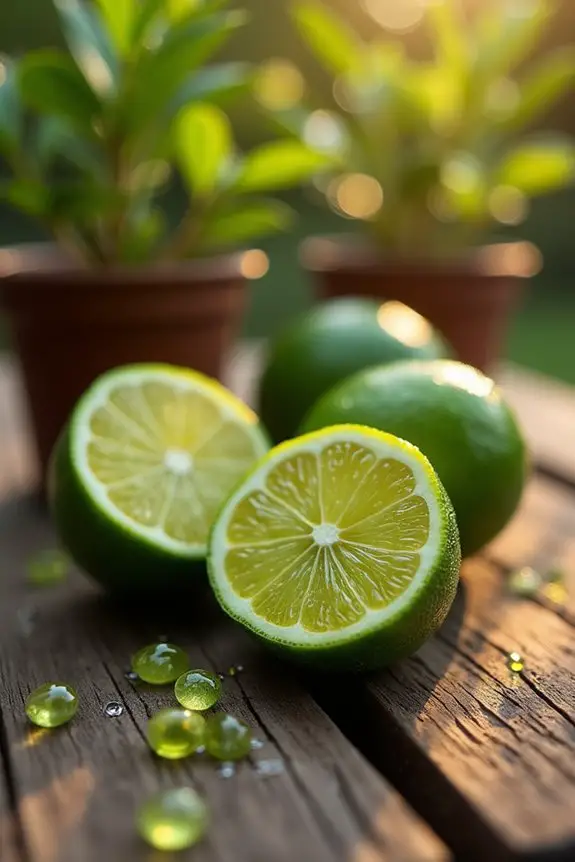
Native to Australian rainforests, finger limes dazzle the culinary world with their caviar-like pearls that burst with tangy citrus brightness.
These slender fruits contain translucent vesicles in stunning shades of pink, green, and pale yellow that pop delightfully on the tongue.
Finger lime varieties range from ruby-red to champagne-colored, each offering unique flavor profiles from sweet to intensely tart.
Their culinary uses extend beyond simple garnishes, transforming cocktails, seafood dishes, and desserts into restaurant-worthy creations.
Growing these compact trees in containers brings exotic elegance to patios and sunrooms, rewarding patient gardeners with jewel-toned harvests that elevate everyday meals into extraordinary experiences.
Monstera Deliciosa (Swiss Cheese Plant Fruit)
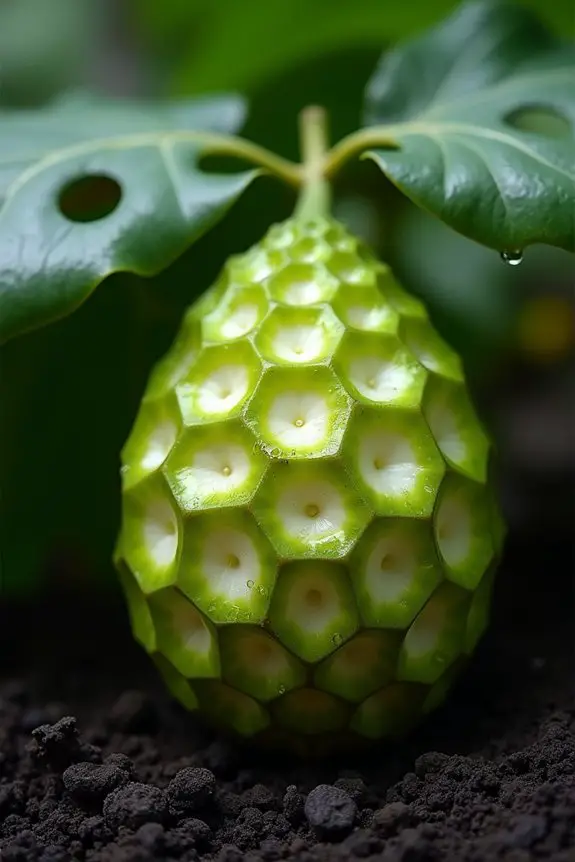
Behind those iconic split leaves beloved by indoor plant enthusiasts hides a spectacular secret: the monstera produces an extraordinary fruit that tastes like a tropical medley of pineapple, banana, and mango.
Growing this delicacy requires patience, as fruits take over a year to ripen completely. Mastering monstera cultivation techniques means providing bright indirect light, consistent warmth, and climbing support.
The monstera fruit benefits include vitamin C, potassium, and unique flavor complexity that transforms ordinary desserts into extraordinary experiences.
Essential Growing Tips:
- Provide sturdy moss poles for upward growth
- Maintain temperatures between 65-85°F consistently
- Water when top two inches feel dry
- Fertilize monthly during growing season
- Harvest only when scales lift easily
Acerola Cherry (Barbados Cherry)
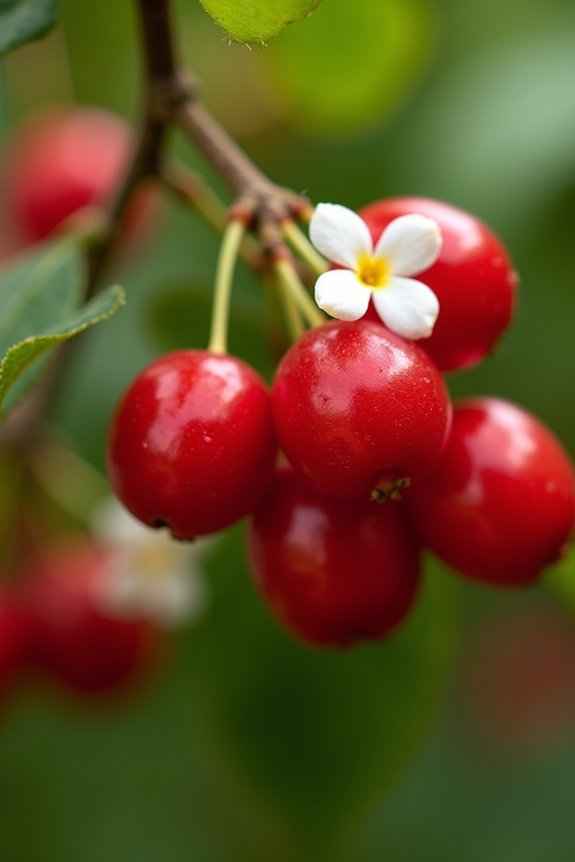
Few fruits pack more vitamin C into their ruby-red flesh than the acerola cherry, a powerhouse that contains up to 65 times more than oranges.
These jewel-toned berries transform backyards into tropical wellness sanctuaries, offering fresh immunity-boosting harvests within arm’s reach.
Understanding acerola cherry cultivation opens doors to year-round abundance in warm climates or container gardens.
| Growing Aspect | Requirement |
|---|---|
| Sunlight | Full sun (6-8 hours daily) |
| Temperature | 65-85°F, frost-sensitive |
| Soil pH | 5.5-6.5 (slightly acidic) |
| Watering | Moderate, well-draining soil |
| Harvest Time | Multiple crops yearly |
Acerola cherry benefits extend beyond nutrition, creating living conversations about sustainable homegrown superfoods.
White Sapote
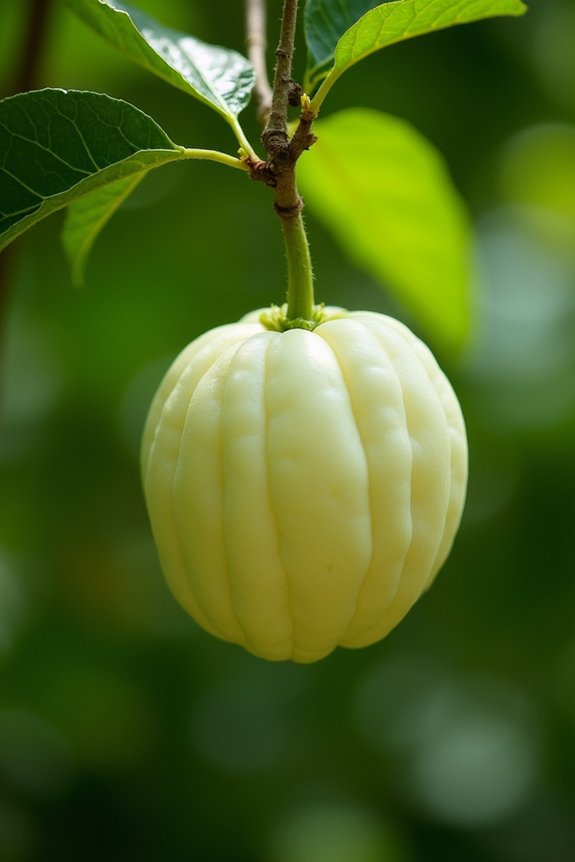
Custard-like sweetness meets tropical elegance in the white sapote, a creamy-fleshed fruit that tastes like vanilla pudding blended with hints of peach and banana.
White sapote cultivation thrives in subtropical climates where frost rarely visits, making it perfect for adventurous gardeners seeking something extraordinary. The tree’s glossy green leaves create stunning shade while producing abundant harvests of pale yellow-green fruits.
Growing Tips for Success:
- Choose popular white sapote varieties like ‘Suebelle’ or ‘Golden Globe’ for reliable fruiting
- Plant in well-draining soil with protection from harsh winds
- Water deeply during fruit development for optimal sweetness
- Harvest when fruits yield gently to pressure
- Enjoy fresh or blend into dreamy smoothies
Popular Questions
Can Tropical Fruits Survive in Cold Climates With Winter Protection Methods?
Some tropical fruits possess varying cold tolerance levels and can survive temperate winters using proper winter protection methods like mulching, frost cloths, and greenhouse shelters. However, sustained freezing temperatures will damage most tropical species regardless of protective measures employed.
How Long Until Tropical Fruit Trees Produce Their First Harvest?
Most tropical fruit trees require 2-5 years before producing their first harvest, though the fruiting timeline varies by species. Dwarf varieties often fruit sooner than standard trees, while proper care accelerates tree growth and overall production timing.
Do Tropical Fruit Plants Attract Unusual Pests or Wildlife to Gardens?
Colorful fruit flies hovering around ripening mangoes illustrate how tropical plants do attract specific insects and animals. Proper pest management becomes essential, as these exotic species create stronger wildlife attraction than typical garden plants, drawing curious birds, bats, and beneficial pollinators.
Can You Grow Multiple Tropical Fruit Varieties in One Container?
Growing multiple tropical fruit varieties in one container is generally not recommended. Container gardening works best with single plants, as different species have varying needs. Fruit compatibility issues arise regarding water requirements, root space, nutrients, and growth rates.
What Permits or Regulations Apply to Growing Exotic Fruits Residentially?
Most residential areas permit exotic fruit cultivation without special authorization. However, certain municipalities impose zoning regulations for commercial-scale operations, while specific species may require plant permits to prevent invasive spread. Approximately 78% of homeowners face no restrictions whatsoever.


